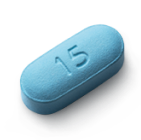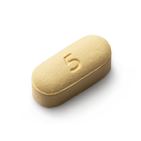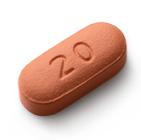DOSING
Convenient combination treatment taken orally once-daily1
Once-daily with or without food as a single tablet1
Bipolar I disorder in adults (manic or mixed episodes)1
Recommended starting dose
(olanzapine and samidorphan)

Monotherapy
10 mg/10 mg

or
15 mg/10 mg

Adjunct to lithium or valproate
10 mg/10 mg

Recommended dose
(olanzapine and samidorphan)

5 mg/10 mga

aOnly for bipolar I disorder maintenance monotherapy.
10 mg/10 mg

or
15 mg/10 mg

or
20 mg/10 mg

Tablets not shown at actual size.
Schizophrenia in adults1
Recommended starting dose
(olanzapine and samidorphan)

5 mg/10 mg

or
10 mg/10 mg

Recommended dose
(olanzapine and samidorphan)

10 mg/10 mg

or
15 mg/10 mg

or
20 mg/10 mg

Tablets not shown at actual size.
- The dosage of samidorphan is fixed at 10 mg across all dosage forms1
- The maximum recommended dosage is 20 mg/10 mg once daily1
- Do not divide tablets or combine strengths1
Additional dosing considerations
Adjusting dosage1
- Dosage may be adjusted at weekly intervals of 5 mg (olanzapine component) depending upon clinical response and tolerability
- For bipolar I disorder monotherapy, dosage adjustments should occur at intervals of not less than 24 hours
- No dosage adjustment is needed for hepatic impairment or patients with mild, moderate, or severe renal impairment1
- Not recommended for end-stage renal disease
Dosage recommendations in specific populations1
- The recommended starting dosage is 5 mg/10 mg once daily in patients who have a higher risk of hypotensive reactions, are at risk of slower olanzapine metabolism, or may be more pharmacodynamically sensitive to olanzapine; if dose escalation is necessary, increase the dosage slowly in these patients
Please see LYBALVI Prescribing Information for additional dosing details.


Opioid use warning
LYBALVI is contraindicated in patients using opioids or undergoing acute opioid withdrawal1
Precipitation of severe opioid withdrawal in patients who are physiologically dependent on opioids1
- Prior to initiating LYBALVI, there should be at least a 7-day opioid-free interval from last use of short‑acting opioids, and at least a 14-day opioid-free interval from the last use of long-acting opioids
- Explain the risks associated with precipitated withdrawal and the importance of giving an accurate account of last opioid use to patients and caregivers
Samidorphan, a component of LYBALVI, can precipitate severe opioid withdrawal in patients who are physiologically dependent on opioids1
- Administration may result in withdrawal syndrome severe enough to require hospitalization


Vulnerability to life-threatening opioid overdose1
- Attempting to overcome LYBALVI's opioid blockade with high or repeated doses of exogenous opioids could lead to life-threatening or fatal opioid intoxication (eg, respiratory arrest, circulatory collapse)
- Inform patients of the potential consequences of trying to overcome the opioid blockade and the serious risks of taking opioids concurrently with LYBALVI or while transitioning off LYBALVI
- Patients with a history of chronic opioid use prior to treatment with LYBALVI may have decreased tolerance to opioids if LYBALVI therapy is interrupted or discontinued
- Advise patients that this decreased tolerance may increase the risk of opioid overdose if opioids are resumed at previously tolerated dosages
In emergency situations, if a LYBALVI-treated patient requires opioid treatment as part of anesthesia or analgesia1:
- Discontinue LYBALVI,
- Opioids should be administered by individual(s) trained in the use of anesthetic drugs and the management of the respiratory effects of opioids, specifically the establishment and maintenance of a patent airway and assisted ventilation, and
- Appropriately trained personnel should continuously monitor the patient in a setting equipped and staffed for cardiopulmonary resuscitation
In non-emergency situations, if a LYBALVI-treated patient is expected to require opioid treatment (eg, for analgesia during or after an elective surgical procedure)1:
- Discontinue LYBALVI at least 5 days before opioid treatment and
- Start olanzapine or another antipsychotic, if needed
Examples of opioids that are contraindicated with LYBALVI include1-9:
- Buprenorphine-containing medicines (eg, Brixadi®, Buprenex®, Butrans®, Suboxone®, Sublocade®, Subutex®, Zubsolv®)
- Codeine-containing medicines (eg, Fioricet® with Codeine, Tylenol with codeine #3, Tylenol with codeine #4)
- Fentanyl (eg, Actiq®, Duragesic®, Fentora®)
- Opium
- Illicit street drugs containing opioids (eg, fentanyl and heroin)
- Hydrocodone-containing medicines (eg, Hycodan, Lorcet-HD®, Lortab®, Vicodin®, Vicoprofen®)
- Hydromorphone (eg, Dilaudid®, Exalgo)
- Meperidine (eg, Demerol®)
- Methadone (eg, Dolophine®, Methadose®)
- Morphine (eg, Kadian®, MS-Contin®, MSIR, Oramorph SR, Roxanol)
- Oliceridine (eg, Olinvyk®)
- Oxycodone-containing medicines (eg, Oxycontin®, Percocet®, Percodan®, Tylox)
- Kratom, an herbal supplement
- Tramadol-containing medicines (eg, Conzip®, Ultracet®, Ultram®)
These are examples of opioids contraindicated with LYBALVI and is not a complete list. Please see LYBALVI Prescribing Information for additional details on LYBALVI use and opioids.
Additional information about opioids can be found here.


LYBALVI Patient Counseling Tool
This resource is intended for use by healthcare providers to support counseling patients about opioid-related safety information for LYBALVI.
Download ToolPlease review the Medication Guide with your patients.

Speak with a LYBALVI sales representative
Next:
Support & Savings for Patients
References: 1. LYBALVI [prescribing information]. Waltham, MA: Alkermes Inc. 2. US Department of Justice Drug Enforcement Administration. Drug and chemical information. Accessed March 14, 2025. https://www.deadiversion.usdoj.gov/drug_chem_info/drug_chem_info.htm. 3. Brixadi [prescribing information]. Cockeysville, MD: Braeburn Inc. 4. Fioricet with codeine [prescribing information]. Irvine, CA: LGM Pharma Solutions, LLC. 5. Acetaminophen and codeine (oral route). Mayo Clinic. March 1, 2025. Accessed March 25, 2025. https://www.mayoclinic.org/drugs-supplements/acetaminophen-and-codeine-oral-route/description/drg-20074117. 6. Drugs of Abuse: a DEA Resource Guide. Washington, DC: Drug Enforcement Administration, US Dept of Justice; 2024. Accessed March 14, 2025. https://www.dea.gov/sites/default/files/2024-12/2024-Drugs-of-Abuse-508.pdf. 7. Proposed adjustments to the aggregate production quotas for Schedule I and II controlled substances and assessment of annual needs for the List I chemicals ephedrine, pseudoephedrine, and phenylpropanolamine for 2021. Fed Regist. 2021;86(168):49346-49354. Accessed March 14, 2025. https://www.govinfo.gov/content/pkg/FR-2021-09-02/pdf/2021-18935.pdf. 8. Olinvyk [prescribing information]. Chesterbrook, PA: Trevena Inc. 9. Conzip [prescribing information]. Alpharetta, GA: Vertical Pharmaceuticals, LLC.